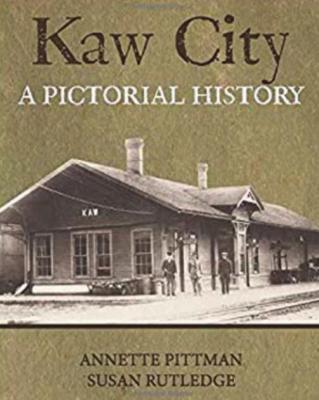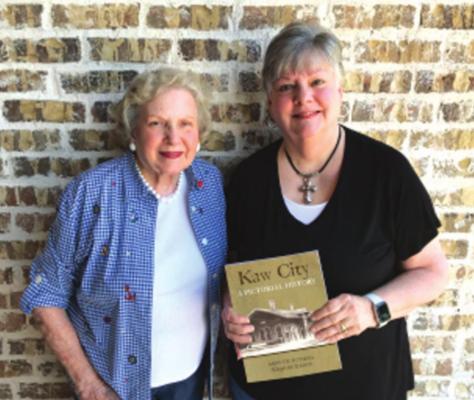Kaw City History Book
Annette Cline Pittman and her daughter Susan Cline Rutledge have created a book titled Kaw City: A Pictorial History. This book is now available at Brace Books and More in Ponca City and at the Kaw City Museum. `
Their work features 200 photographs and descriptions covering the history of the old Kaw City before it was flooded by the creation of what is known today as Kaw Lake and Dam. The original Kaw City was located about 12 miles east and slightly north of Ponca City on State Highway 11 in Kay County. The town was situated in what is called the Ox Bow Bend of the Arkansas River.
The town was established by the Kaw City Townsite Company, which sold lots beginning on July 4, 1902. It was promoted as a place for business land as level as a floor with gently sloping upland for residences. It was bordered on the north by the Kaw (Kansa) Reservation and on the east by the Osage Reservation. Situated in a fertile and productive farming and cattle region, Kaw City was connected with outside markets when the Atchison, Topeka and Santa Fe Railway built their line through the town. Completed in 1903, the train depot served as a shipping point for thousands of bushels of corn and other farm produce. Hundreds of carloads of Texas cattle moved through Kaw City into the grazing lands of the Osage Reservation for fattening prior to being transported to market.
From the town’s inception, building progressed rapidly. Kaw City soon had a bank, a newspaper, two lumberyards, and a mill. A wagon bridge built across the Arkansas River to the north increased trade from the area known as Kaw Country. A post office was established on September 12, 1902, and a one-room school opened with fifty-six children in November 1902. At 1907 statehood, the city population stood at 486.
In 1919 a building boom started when oil was struck east of Kaw City. Roads were widened, gas was piped into town, Main Street was paved, old buildings were replaced with new ones, and bonds were passed for a city water and sewer system. The population almost doubled from 627 in 1920 to 1,001 in 1930. In the 1920s Kaw City became internationally known due to the art collection of Laura A. Clubb, wife of a rancher. An avid collector of paintings, she displayed them in her husband’s three-story, brick hotel. Later in order to keep her amassed paintings and rare books intact for the future, she donated them to the Philbrook Museum of Art in Tulsa.
Kaw City suffered several setbacks. In 1923 a flood damaged the business district and destroyed two bridges, of which only one was reconstructed. During the Great Depression numerous businesses closed. At the beginning of World War II many citizens left to join the armed forces and to gain higher-paying, defense industry jobs. The town never regained the status it had once enjoyed. The population dropped from1,001 in 1930 to 561 in 1950.
The next blow came with the construction of the Kaw Dam which was completed in 1976. As the lake rose it completely covered the original town. In the years preceding the flooding of the old Kaw City, a new city was created nearby at a higher elevation. The original Santa Fe depot was moved to the new city and it became the Kaw City Museum. Many will remember the original bank moved to Ponca City and was renamed Pioneer Bank and Trust.
Over the years the creators of this book, Annette Pittman and her daughter Susan Rutledge, have been very active in preserving the history of Kaw City at the local museum. Their book, along with the other artifacts at the museum in Kaw City, will continue to ensure the history will not be forgotten.
This book is now on display with many other local history books at Brace Books and More in Ponca City and at the Kaw City Museum in Kaw City.
For further information you may call the bookstore at 580-765-5173 or the museum at 580-269-2366


